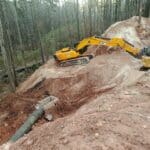How Sinkholes Form in Pennsylvania
What Causes Sinkholes in Pennsylvania?
What causes sinkholes in Pennsylvania? Much of it has to do with karst terrain. Pennsylvania’s geology is characterized by extensive karst terrain, a landscape shaped by dissolved soluble bedrock, primarily limestone and dolomite.
This process, driven by the interaction between water and the bedrock, creates a network of underground cavities, cracks and channels that gradually expand over time.
The Role of Water in Sinkhole Formation
Water is the primary catalyst in creating sinkholes, playing a crucial role in the dissolution of the underlying bedrock. Rainwater, groundwater and even stormwater drainage can all contribute to this process. Stormwater runoff solutions can help mitigate this issue. As water seeps through cracks and fissures in the bedrock, it dissolves the limestone or dolomite, enlarging the existing cavities and creating new ones.
Where Sinkholes Commonly Form in Pennsylvania
Pennsylvania’s karst terrain is widely distributed throughout the state, with sinkhole-prone areas in Pennsylvania in the Great Valley, the Lehigh Valley and the central regions. The prevalence of sinkholes in these areas is influenced by several factors, including the overburden’s depth and composition, the bedrock dissolution rate and the presence of water sources that can exacerbate the process.
Types of Sinkholes in Pennsylvania
Sinkholes in Pennsylvania can take on various forms, each with unique characteristics and underlying mechanisms. Understanding these distinct types is crucial for effective prevention and sinkhole remediation.
Cover-Collapse Sinkholes
Cover-collapse sinkholes occur when the overburden can no longer support its weight, leading to an abrupt collapse into the underlying void. Heavy rainfall, broken water pipes, or construction activities often trigger this type of sinkhole. For this reason, a bus in Pennsylvania fell into a sinkhole.
Cover-Subsidence Sinkholes
Cover-subsidence sinkholes develop gradually over time. As water permeates the overburden, typically sandy soil, the sediment slowly migrates into the underlying cavities, creating a gradual depression on the surface.
Dissolution Sinkholes
Dissolution sinkholes form when the overburden is thin or absent, allowing the exposed bedrock to interact directly with acidic water.
Sinkhole Prevention & Contributing Factors
While sinkholes are natural, human activities can contribute to their formation and exacerbate their impacts. Understanding the various triggers that can initiate sinkhole development is crucial for prevention and mitigation efforts. How sinkholes are formed includes the following:
- Sinkhole stormwater and drainage issues
- Construction and land disturbance
- Natural disasters and extreme weather events
Detecting & Monitoring Sinkhole Risks
Proactive detection and monitoring of potential sinkhole risks are crucial for mitigating the impact of these geohazards. Various techniques and technologies are employed to identify and track the development of sinkholes and for sinkhole repair in Pennsylvania, including the following:
- Geophysical surveys
- Monitoring and instrumentation
- Sinkhole inventories and mapping
Sinkhole Remediation and Mitigation Strategies
When sinkholes occur, remediation, mitigation, and urban stormwater management strategies can be employed to address the immediate threat and prevent future occurrences.
- Grouting and stabilization
- Drainage and water management
- Structural reinforcement
- Proactive planning and regulation
Contact us to learn more about sinkholes or to get a consultation.
How Are Sinkholes Formed? FAQs
Where do water sinkholes lead to?
Water sinkholes are connected to underground drainage systems and conduits.
How does drainage cause sinkholes?
How sinkholes are formed due to improper drainage: When water accumulates and percolates into the ground, it can dissolve the underlying carbonate bedrock, enlarging existing cracks and cavities.
Which US state has the most sinkholes?
Florida is often cited as the state with the most sinkholes, particularly in the central and west-central regions.
What is the main trigger for sinkholes?
The primary trigger for sinkhole formation is the destabilization of the ground, often caused by human activities or natural processes.
Can sinkholes be fixed?
Yes, sinkholes can be repaired, but the approach varies depending on the type and severity of the sinkhole.
Who is responsible for fixing sinkholes?
Sinkhole repair often falls on the property owner, as sinkholes are typically considered a natural hazard. However, in some cases, local authorities or government agencies may be involved.
What is the most common cause of a sinkhole?
The most common cause of how sinkholes are formed is water’s gradual dissolution of the underlying carbonate bedrock.
Can heavy rain cause sinkholes?
Excessive precipitation can increase the amount of water infiltrating the ground, accelerating the dissolution of the bedrock and enlarging existing cavities.
How do water sinkholes form?
Water sinkholes, also known as cover-subsidence sinkholes, form gradually as water permeates the soil and sediment above the bedrock.
How are sinkholes related to water?
Water’s dissolution of soluble bedrock is the primary mechanism behind sinkhole formation.
How might sinkholes affect water quality?
Sinkholes can significantly impact water quality, both in surface and groundwater. To learn more about how to repair sinkholes, contact AQUALIS today.
 Kenosha, Wis. Highway KR Regenerative Stormwater ConveyanceThe Root-Pike Watershed Initiative Network Kenosha County, and others worked with AQUALIS to design and implement an innovative solution for stormwater control along Highway KR.
Kenosha, Wis. Highway KR Regenerative Stormwater ConveyanceThe Root-Pike Watershed Initiative Network Kenosha County, and others worked with AQUALIS to design and implement an innovative solution for stormwater control along Highway KR. Durham, N.C. Sinkhole Leads to Stormwater System RehabilitationThe tenant on this property noticed a depression that opened to the ground below and notified the property owners.
Durham, N.C. Sinkhole Leads to Stormwater System RehabilitationThe tenant on this property noticed a depression that opened to the ground below and notified the property owners.




